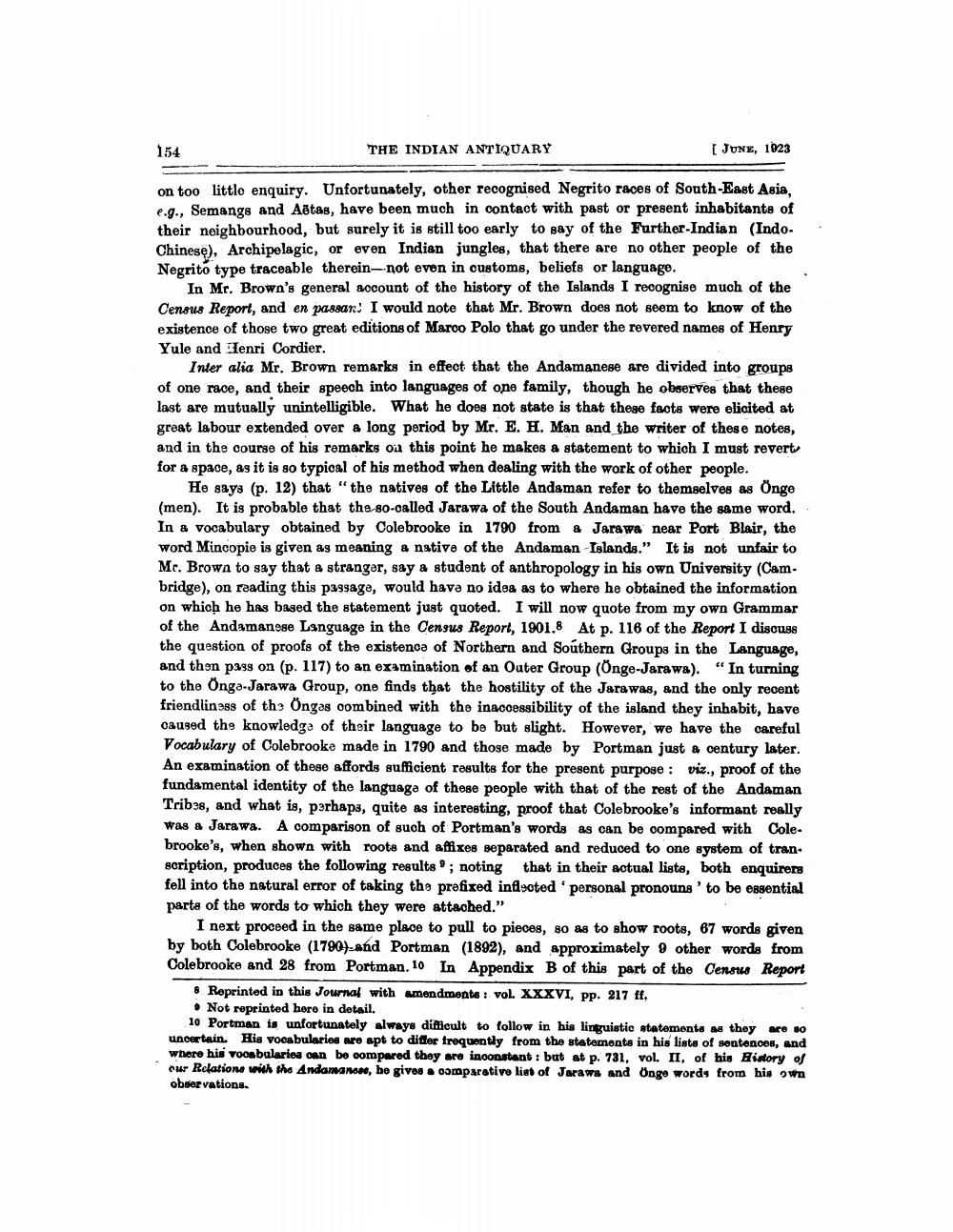________________
154
THE INDIAN ANTIQUARY
[ JUNE, 1023
on too littlo enquiry. Unfortunately, other recognised Negrito races of South-East Asia, e... Semange and Abtas, have been much in contact with past or present inhabitants of their neighbourhood, but surely it is still too early to say of the Further Indian (Indo. Chinese), Archipelagic, or even Indian jungles, that there are no other people of the Negrito type traceable therein-not even in customs, beliefs or language.
In Mr. Brown's general account of the history of the Islands I recognise much of the Census Report, and en passar) I would note that Mr. Brown does not seem to know of the existence of those two great editions of Marco Polo that go under the revered names of Henry Yule and lenri Cordier.
Inter alia Mr. Brown remarks in effect that the Andamanese are divided into groups of one race, and their speech into languages of one family, though he observes that these last are mutually unintelligible. What he does not state is that these foots were elicited at great labour extended over a long period by Mr. E. H. Man and the writer of these notes, and in the course of his remarks oa this point he makes & statement to which I must revert for a space, as it is so typical of his method when dealing with the work of other people.
He says (p. 12) that "the natives of the Little Andaman refer to themselves as Onge (men). It is probable that the 80-called Jarawa of the South Andaman have the same word. In a vocabulary obtained by Colebrooke in 1790 from a Jarawa near Port Blair, the word Mincopie is given as meaning a native of the Andaman Islands." It is not unfair to Mc. Brown to say that a stranger, say a student of anthropology in his own University (Cam. bridge), on reading this passage, would have no idea as to where he obtained the information on which he has based the statement just quoted. I will now quote from my own Grammar of the Andamanese Language in the Census Report, 1901.8 At p. 116 of the Report I discuss the question of proofs of the existence of Northern and Southern Groups in the Language, and then pa9s on (p. 117) to an examination of an Outer Group (Onge-Jarawa). "In turning to the Onga-Jarawa Group, one finds that the hostility of the Jarawas, and the only recent friendlines of th) Ongas combined with the inaccessibility of the island they inhabit, have caused the knowledge of their language to be but slight. However, we have the careful Vocabulary of Colebrooke made in 1790 and those made by Portman just a century later. An examination of these affords sufficient results for the present purpose : viz., proof of the fundamental identity of the languaga of these people with that of the rest of the Andaman Tribəs, and what is, perhaps, quite as interesting, proof that Colebrooke's informant really was a Jarawa. A comparison of such of Portman's words as can be compared with Colebrooke's, when shown with roots and affixes separated and reduced to one system of tran. scription, produces the following results; noting that in their actual lists, both enquirers fell into the natural error of taking the prefixed inflected ' personal pronouns' to be essential parts of the words to which they were attached."
I next proceed in the same place to pull to pieces, so as to show roots, 67 words given by both Colebrooke (1790) and Portman (1892), and approximately 9 other words from Colebrooke and 28 from Portman. 10 In Appendix B of this part of the Census Report
& Roprinted in this Journal with amendments : vol. XXXVI, pp. 217 ft. . Not reprinted here in detail.
10 Portman is unfortunately always difficult to follow in his linguistic atatements as they are so uncertain. His vocabularios no apt to differ frequently from the statements in his lists of sentonces, and where his vooabularies can be compared they are inconstant : but at p. 731, vol. II, of his History of our Relations with the Andamanono, bo gives a comparative list of Jarawa and Onge words from his own observations.




